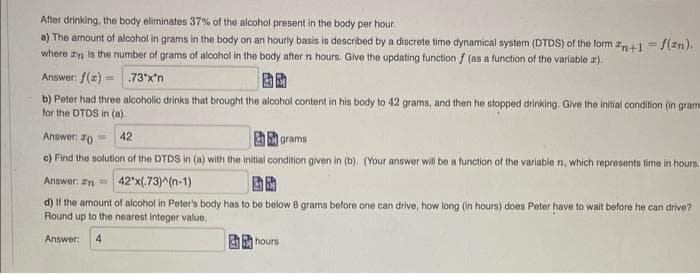After drinking, the body eliminates 37% of the alcohol present in the body per hour. f(zn) a) The amount of alcohol in grams in the body on an hourly basis is described by a discrete time dynamical system (DTDS) of the form n+1 = where is the number of grams of alcohol in the body after n hours. Give the updating function f (as a function of the variable z). Answer: f(z) = .73'x'n b) Peter had three alcoholic drinks that brought the alcohol content in his body to 42 grams, and then he stopped drinking. Give the initial condition (in gra for the DTDS in (a). Answer: 0 42 grams e) Find the solution of the DTDS in (a) with the initial condition given in (b). (Your answer will be a function of the variable n, which represents time in hour 40tul 70146
After drinking, the body eliminates 37% of the alcohol present in the body per hour. f(zn) a) The amount of alcohol in grams in the body on an hourly basis is described by a discrete time dynamical system (DTDS) of the form n+1 = where is the number of grams of alcohol in the body after n hours. Give the updating function f (as a function of the variable z). Answer: f(z) = .73'x'n b) Peter had three alcoholic drinks that brought the alcohol content in his body to 42 grams, and then he stopped drinking. Give the initial condition (in gra for the DTDS in (a). Answer: 0 42 grams e) Find the solution of the DTDS in (a) with the initial condition given in (b). (Your answer will be a function of the variable n, which represents time in hour 40tul 70146
Linear Algebra: A Modern Introduction
4th Edition
ISBN:9781285463247
Author:David Poole
Publisher:David Poole
Chapter2: Systems Of Linear Equations
Section2.4: Applications
Problem 15EQ
Related questions
Question
Answer all the parts otherwise don't solve.

Transcribed Image Text:After drinking, the body eliminates 37% of the alcohol present in the body per hour.
a) The amount of alcohol in grams in the body on an hourly basis is described by a discrete time dynamical system (DTDS) of the form n+1 = f(n).
where an is the number of grams of alcohol in the body after n hours. Give the updating function f (as a function of the variable z).
Answer: f(z)=
.73*x*n
b) Peter had three alcoholic drinks that brought the alcohol content in his body to 42 grams, and then he stopped drinking. Give the initial condition (in grama
for the DTDS in (a).
42
grams
Answer: 0
e) Find the solution of the DTDS in (a) with the initial condition given in (b). (Your answer will be a function of the variable n, which represents time in hours.
Answer: n = 42*x(.73)^(n-1)
d) If the amount of alcohol in Peter's body has to be below 8 grams before one can drive, how long (in hours) does Peter have to wait before he can drive?
Round up to the nearest integer value.
Answer: 4
hours
Expert Solution
This question has been solved!
Explore an expertly crafted, step-by-step solution for a thorough understanding of key concepts.
Step by step
Solved in 4 steps

Recommended textbooks for you

Linear Algebra: A Modern Introduction
Algebra
ISBN:
9781285463247
Author:
David Poole
Publisher:
Cengage Learning

Algebra & Trigonometry with Analytic Geometry
Algebra
ISBN:
9781133382119
Author:
Swokowski
Publisher:
Cengage

Linear Algebra: A Modern Introduction
Algebra
ISBN:
9781285463247
Author:
David Poole
Publisher:
Cengage Learning

Algebra & Trigonometry with Analytic Geometry
Algebra
ISBN:
9781133382119
Author:
Swokowski
Publisher:
Cengage